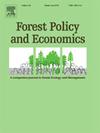An assessment of forest use and it's benefits on livelihoods: A case of the Baka and Bantu communities, Southeast Cameroon
IF 4
2区 农林科学
Q1 ECONOMICS
引用次数: 0
Abstract
The ways in which local people incorporate forest activities into their livelihood strategies vary considerably. In this study, we aim to evaluate the livelihoods of local people in relation to their use of forests by comparing their time allocation and involvement frequency in various forest-related activities in two localities in southeast Cameroon. We followed 80 persons using the individual tracing method to examine variations in the time allocated to forest-related activities and quantities of the most important non-timber forest products (NTFPs) collected depending on ethnic groups, genders and locations. Estimation results from this work showed a significant difference in the time allocated to NTFPs gathering and farming between the Baka and Bantu people, and no significant gender or location differences. Also, there was a significant difference in hunting time between Malea Ancien and Bintom but no ethnic differences. The quantities of the most important NTFPs collected varied between ethnic groups and genders, but not between locations. Our findings showed NTFPs gathering to be the most important livelihood activity of local people in terms of their time allocation, with forest use differing between ethnic groups, genders and locations. Moreover, scarcity of forest products caused by access restrictions might force local people to change their patterns of production and consumption which might be detrimental for conservation. Our results contribute to local understanding of forest use and to reconcile this with the livelihood of local people in the region to better inform decisions and policies concerning forest management.
评估森林利用及其对生计的益处:喀麦隆东南部巴卡人和班图人社区的案例
当地人将森林活动纳入其生计战略的方式大相径庭。在这项研究中,我们旨在通过比较喀麦隆东南部两个地区的当地人在各种森林相关活动中的时间分配和参与频率,来评估当地人利用森林的生计情况。我们采用个体追踪法对 80 人进行了跟踪调查,研究了不同民族、性别和地区在森林相关活动时间分配和最重要的非木材森林产品(NTFP)采集数量上的差异。这项工作的估算结果显示,巴卡人和班图人分配给非木材森林产品采集和耕作的时间存在显著差异,而性别和地点差异不明显。此外,Malea Ancien 和 Bintom 的狩猎时间也有显著差异,但没有种族差异。采集的最重要的非物质文化遗产的数量在不同种族和性别之间存在差异,但在不同地点之间没有差异。我们的研究结果表明,就时间分配而言,采集非物质森林产品是当地人最重要的谋生活动,不同民族、性别和地点对森林的利用也不尽相同。此外,进入限制造成的林产品稀缺可能迫使当地人改变生产和消费模式,这可能不利于保护。我们的研究结果有助于当地人了解森林的使用情况,并将其与该地区当地人的生计相协调,从而更好地为有关森林管理的决策和政策提供信息。
本文章由计算机程序翻译,如有差异,请以英文原文为准。
求助全文
约1分钟内获得全文
求助全文
来源期刊

Forest Policy and Economics
农林科学-林学
CiteScore
9.00
自引率
7.50%
发文量
148
审稿时长
21.9 weeks
期刊介绍:
Forest Policy and Economics is a leading scientific journal that publishes peer-reviewed policy and economics research relating to forests, forested landscapes, forest-related industries, and other forest-relevant land uses. It also welcomes contributions from other social sciences and humanities perspectives that make clear theoretical, conceptual and methodological contributions to the existing state-of-the-art literature on forests and related land use systems. These disciplines include, but are not limited to, sociology, anthropology, human geography, history, jurisprudence, planning, development studies, and psychology research on forests. Forest Policy and Economics is global in scope and publishes multiple article types of high scientific standard. Acceptance for publication is subject to a double-blind peer-review process.
 求助内容:
求助内容: 应助结果提醒方式:
应助结果提醒方式:


